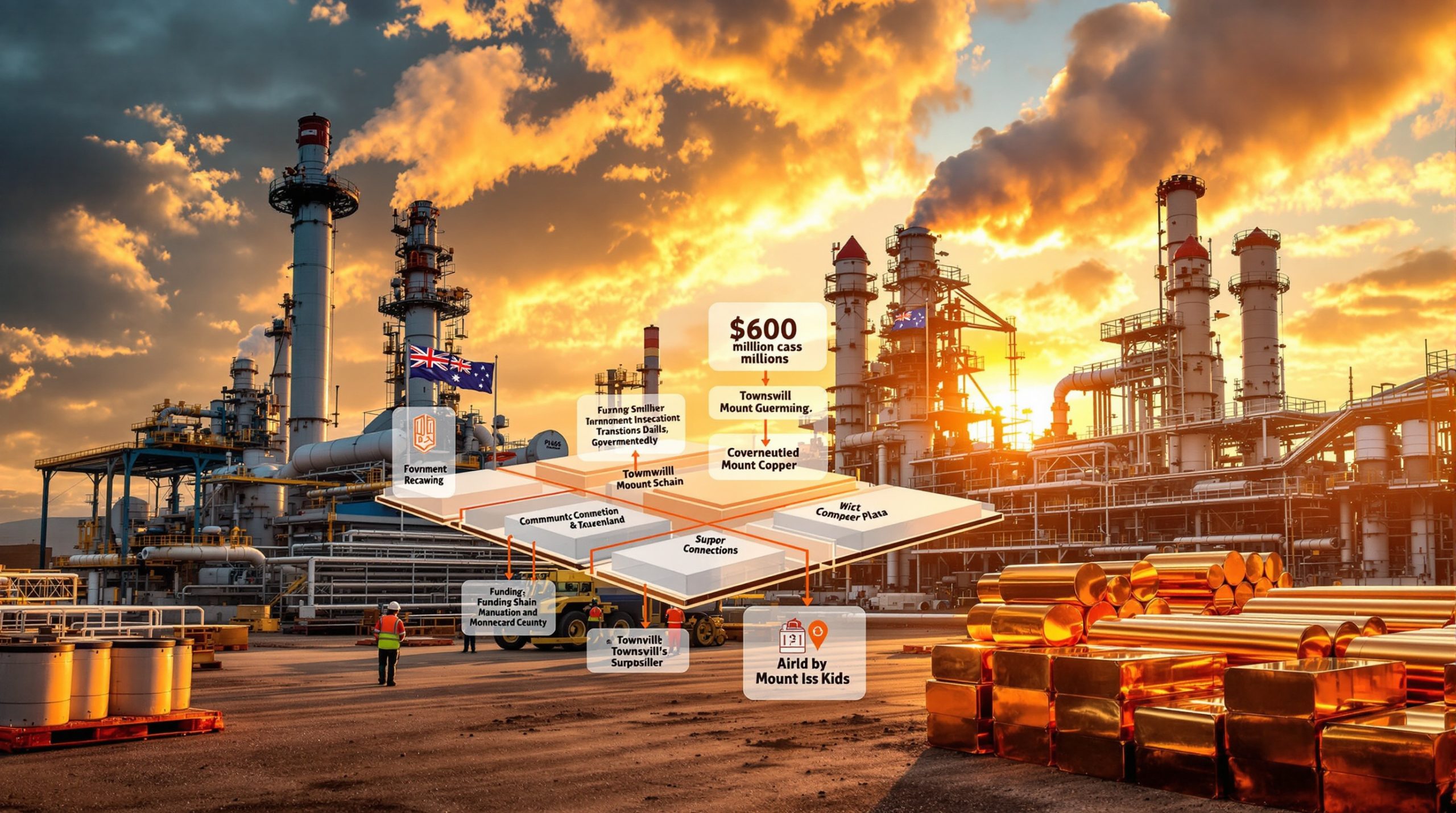What is the Mount Isa Copper Agreement and Why Does it Matter?
The Mount Isa copper agreement represents a critical milestone for Australia's mining and manufacturing industries. This landmark deal ensures the continued operation of vital copper processing facilities in Queensland while protecting thousands of jobs across northern Australia. The agreement secures Australia's position in the global copper supply chain at a time when refined copper has become increasingly strategic for energy transition technologies and infrastructure development.
The $600 million co-investment package between Glencore and Australian governments not only preserves existing capabilities but also provides time to develop long-term solutions for maintaining domestic processing capacity. As global competition intensifies and international players invest heavily in their own processing infrastructure, this agreement signals Australia's commitment to maintaining sovereign capabilities in critical mineral refining.
The $600 Million Lifeline: Understanding the Government-Industry Partnership
What exactly is the Mount Isa copper agreement?
The Mount Isa copper agreement is a $600 million co-investment package between mining giant Glencore and the Australian and Queensland governments. The funding is split equally, with the federal and Queensland governments each contributing $300 million over a three-year period. This strategic partnership aims to keep the Mount Isa Copper Smelter and Townsville Refinery operational until at least 2028, preserving critical infrastructure that might otherwise have faced imminent closure.
This cooperative model demonstrates how public and private sectors can collaborate to maintain strategic assets during challenging economic conditions. The agreement not only addresses immediate financial constraints but also creates a framework for exploring longer-term sustainability solutions.
Why was government intervention necessary?
The facilities had been operating with significant financial losses for several years, with Glencore absorbing these costs while seeking sustainable alternatives. Industry analysis indicates several factors contributed to the financial pressure:
- Rising energy costs making Australian processing less competitive globally
- Environmental compliance requirements adding operational expenses
- Aging infrastructure requiring substantial capital investment
- International competition from newer, more efficient facilities
- Volatile copper prices affecting profit margins
Without this support package, the smelter and refinery faced closure within months, which would have triggered devastating economic consequences throughout northern Queensland. The intervention represents a recognition that certain industrial capabilities have strategic value beyond immediate profitability.
How is the funding structured?
The support package includes a carefully designed funding structure:
- $400 million allocated across the first two years ($200 million per year)
- A third-year contingent payment of $200 million, dependent on all parties meeting their obligations
- Critical maintenance funding, particularly for the essential full rebrick of the Mount Isa smelter scheduled for 2026
- Regular performance reviews to ensure accountability and proper fund utilization
This phased approach provides immediate stability while creating incentives for operational improvements and long-term planning. The contingent third-year funding encourages all stakeholders to work toward sustainable operations.
Economic Impact: Jobs, Communities, and Regional Prosperity
How many jobs does the agreement protect?
The Mount Isa complex directly employs approximately 600 workers across its operations, but the economic footprint extends far beyond these immediate positions. According to Townsville Enterprise estimates, the facilities underpin as many as 17,000 jobs across northern Queensland through contractors, suppliers, and service providers.
| Impact Level | Jobs Supported | Description |
|---|---|---|
| Direct Employment | 600 | Workers at the Mount Isa smelter and Townsville refinery |
| Supply Chain | ~4,000 | Contractors, maintenance services, and direct suppliers |
| Regional Economy | Up to 17,000 | Broader economic impact including service industries, retail, and community support sectors |
The preservation of these jobs maintains critical technical expertise and specialized industrial skills that would be difficult to reconstitute if lost. Many of these positions represent multi-generational employment in communities where alternative opportunities are limited.
What communities benefit most from this agreement?
The agreement provides vital economic stability for several key regions:
-
Mount Isa: This mining town's identity and economy are deeply intertwined with resource processing. Local businesses, housing markets, and community services all depend heavily on the continued operation of the copper smelter.
-
Townsville: As Queensland's largest regional city, Townsville benefits significantly from the copper refinery's presence. The facility represents one of the city's major industrial employers and supports numerous secondary businesses.
-
Surrounding communities: Smaller towns and service centers along transportation routes between Mount Isa and Townsville rely on the mining supply chain. These communities provide accommodation, services, and logistics support.
The regional impact extends to Indigenous communities as well, with several Native Title groups maintaining employment and business relationships with the facilities.
Beyond jobs: What other economic benefits does the agreement deliver?
The continuation of operations preserves numerous economic benefits beyond direct employment:
-
Local business revenue: Hundreds of regional businesses provide services to the facilities, from engineering and maintenance to catering and accommodation.
-
Regional tax base: The operations contribute significantly to local government revenues, supporting community infrastructure and services.
-
Skills retention: Maintaining these facilities preserves specialized technical knowledge and industrial capabilities that would otherwise leave the region.
-
Educational opportunities: Technical training programs and apprenticeships continue to develop the next generation of skilled workers.
-
Downstream manufacturing: Australian manufacturers benefit from reliable access to domestically produced copper, supporting value-added industries.
By maintaining these economic pillars, the agreement helps prevent the destabilizing cycle of population decline and service reduction that often follows major industrial closures in regional areas.
Strategic Significance: Australia's Copper Processing Capabilities
Why is domestic copper processing strategically important?
The Mount Isa and Townsville facilities represent approximately half of Australia's copper smelting capacity. Maintaining these operations ensures:
-
Sovereign capability: Preserving domestic processing reduces reliance on overseas refineries, particularly important during supply chain disruptions or geopolitical tensions.
-
Value-adding: Processing copper domestically captures more economic value than exporting raw concentrate, supporting higher-paying jobs and greater economic returns.
-
Supply chain security: Australian manufacturers gain more reliable access to refined copper, reducing vulnerability to international market fluctuations.
-
Technological capacity: The facilities maintain technical expertise and innovation capabilities that would be difficult to rebuild if lost.
The Townsville refinery processes up to 300,000 tonnes of copper cathode annually, producing high-purity material essential for electrical applications, renewable energy infrastructure, and advanced manufacturing.
How does this fit into Australia's critical minerals strategy?
The agreement aligns with broader national objectives to strengthen Australia's position in global critical minerals markets:
-
Energy transition support: Refined copper is essential for renewable energy infrastructure, electric vehicles, and grid modernization.
-
Domestic manufacturing foundation: The "Future Made in Australia" agenda relies on secure access to materials like refined copper.
-
Value chain resilience: Maintaining processing capabilities reduces vulnerability to international supply disruptions.
-
Strategic positioning: The agreement helps Australia remain competitive as other countries invest heavily in securing critical minerals supply chains.
By preserving these processing capabilities, Australia maintains its ability to participate in higher-value segments of the global copper market rather than being relegated to supplying raw materials for processing elsewhere.
Industry Perspective: What This Means for Australian Mining
How does this agreement compare to other industry support measures?
The Mount Isa copper agreement follows similar government interventions in Australian metals processing but with distinctive characteristics:
-
Scale: The $600 million package represents one of the larger targeted industry support measures in recent years.
-
Strategic focus: Unlike broader industry assistance programs, this agreement specifically targets infrastructure with strategic significance.
-
Regional emphasis: The support explicitly recognizes the importance of maintaining economic activity in northern Queensland.
-
Co-investment model: The partnership approach shares responsibilities between government and industry rather than providing direct subsidies.
This approach reflects evolving thinking about how governments can support strategic industries through transitional periods while working toward longer-term sustainable solutions.
What does this signal about the future of Australian mineral processing?
The agreement indicates several important shifts in thinking about Australia's resources sector:
-
Strategic value recognition: There's growing acknowledgment that some industrial capabilities have national importance beyond immediate profitability.
-
Transition planning: Rather than allowing abrupt closures, there's more emphasis on managed transitions that protect communities and capabilities.
-
Public-private partnership: Complex industrial challenges increasingly require collaboration between government and industry.
-
Supply chain focus: Australia is becoming more attentive to maintaining complete supply chains rather than focusing exclusively on extraction.
Industry analysts note that the decision ensures Glencore's Australian copper remains part of the local value chain rather than being exported overseas for refining, establishing a model for collaborative investment between public and private sectors to protect regional economies.
Future Outlook: Beyond the Three-Year Horizon
What happens after the three-year support period ends?
The agreement includes provisions for longer-term planning:
-
Transformation study: A comprehensive assessment will explore long-term industrial options for the Mount Isa region, including potential technology upgrades and diversification opportunities.
-
Regular reviews: Performance monitoring will assess operational improvements and changing market conditions.
-
Environmental planning: The agreement provides time to develop more sustainable environmental practices and compliance strategies.
-
Economic diversification: Regional stakeholders will use the three-year window to strengthen and diversify the economic base of affected communities.
Troy Wilson, Glencore Metals Australia interim COO, characterized the agreement as "a short-term lifeline" that could help secure a stronger, more sustainable copper industry for Queensland, acknowledging that permanent solutions will require further innovation and adaptation.
What challenges remain for copper processing in Australia?
Despite the agreement, several significant challenges persist:
-
Energy costs: Australian energy prices remain high relative to international competitors, creating ongoing cost pressure.
-
Aging infrastructure: The facilities will require continued investment beyond the current agreement to remain competitive.
-
Environmental standards: Meeting increasingly stringent environmental requirements will demand new technologies and practices.
-
International competition: China and other nations continue to expand their processing capabilities with newer, more efficient facilities.
-
Market volatility: Copper prices remain subject to significant fluctuations, affecting long-term planning.
Addressing these copper market challenges will require continued innovation, investment, and potentially new policy approaches to ensure Australian processing remains viable beyond the current agreement.
Interconnected Industries: The Broader Economic Web
How does the copper agreement affect other industries?
The continuation of copper processing operations has significant implications for multiple interconnected sectors:
-
The Dyno Nobel Phosphate Hill fertilizer plant: This facility relies on sulfuric acid produced as a byproduct at the Mount Isa smelter. Without this local source, fertilizer production costs would increase substantially.
-
Agricultural production: Queensland farmers benefit from locally produced fertilizers, maintaining competitive input costs.
-
Construction and infrastructure: Australian builders maintain reliable access to domestically produced copper for electrical systems and plumbing.
-
Renewable energy manufacturing: As Australia expands its renewable energy production, locally refined copper supports domestic manufacturing of components like solar inverters and wind turbine components.
-
Electrical equipment production: Australian manufacturers of electrical equipment benefit from supply chain security and reduced logistics costs.
This interconnectedness demonstrates how maintaining one industrial capability can support numerous other sectors throughout the economy.
What would have been lost if the facilities had closed?
Beyond immediate job losses, closure would have triggered cascading effects:
-
Supply chain disruption: Integrated industrial processes relying on the facilities would face higher costs and reliability challenges.
-
Technical expertise exodus: Specialized skills and knowledge would likely leave the region permanently.
-
Community services decline: Reduced population and economic activity would threaten schools, healthcare facilities, and other essential services.
-
Infrastructure deterioration: Once decommissioned, industrial facilities of this scale are rarely reactivated due to the prohibitive costs of maintaining idle equipment.
-
Investment confidence: Closure would likely reduce investor confidence in other regional industrial projects.
The agreement's prevention of these consequences represents significant value beyond the direct operations of the facilities themselves.
Political and Stakeholder Reactions
How have different stakeholders responded to the agreement?
The agreement has generated varied responses across the political and economic spectrum:
-
Industry groups have welcomed the preservation of critical infrastructure and the recognition of domestic processing's strategic importance.
-
Labor unions praised the protection of skilled jobs in regional areas and the commitment to maintaining industrial capabilities.
-
Local governments expressed relief at the economic stability provided, particularly given limited alternative employment options in the regions.
-
Environmental organizations have offered mixed responses, with some acknowledging the opportunity to implement improved practices and others questioning the sustainability of supporting older facilities.
-
Economic commentators have debated the long-term viability of government support for industrial operations facing structural challenges in global markets.
These diverse perspectives reflect the complex balance between immediate economic needs, long-term strategic planning, and environmental considerations.
What does State Member Robbie Katter say about the agreement?
State Member for Traeger Robbie Katter welcomed the deal but emphasized the need for more comprehensive planning:
"The Federal Government in particular have recognized the strategic importance of keeping the smelter operating. We need them to remain at the negotiating table to reform the smelter operations, not just continually save it."
Katter's comments highlight several important considerations:
- Acknowledgment of the strategic value recognized by the federal government
- Concern about repeated short-term interventions rather than structural solutions
- Emphasis on reforming operations to address underlying viability issues
- Recognition that government engagement must extend beyond initial funding
His perspective represents the views of many regional stakeholders who support the immediate intervention but seek more fundamental solutions for long-term sustainability.
FAQ: Key Questions About the Mount Isa Copper Agreement
Why is copper processing particularly important for Australia's future?
Copper stands at the center of the global energy transition, with demand expected to increase significantly in coming decades. This metal is essential for:
- Renewable energy infrastructure (solar panels, wind turbines)
- Electric vehicle production (motors, charging systems)
- Energy storage systems
- Modern power grids and transmission infrastructure
- Telecommunications equipment
Maintaining domestic processing capability positions Australia to capture more value from this growing demand rather than merely exporting raw materials for others to process and benefit from.
How does the agreement affect Australia's export profile?
Rather than exporting raw copper concentrate for processing overseas, the agreement ensures Australia can continue producing higher-value refined copper products. This maintains:
- A more diversified export portfolio
- Higher value per tonne of material exported
- Greater resilience to commodity price fluctuations
- Stronger positioning in global supply chains
- Enhanced trade relationships with manufacturing nations
The difference between exporting raw materials and refined products represents billions in potential economic value over the life of the facilities.
What environmental considerations are addressed in the agreement?
While specific environmental provisions haven't been fully detailed publicly, the funding for facility upgrades provides opportunities to improve environmental performance:
- Modernization of pollution control systems
- Energy efficiency improvements
- Waste management upgrades
- Water conservation initiatives
- Emissions reduction technologies
The three-year timeframe also allows for more comprehensive planning around environmental compliance and sustainability initiatives that might not be possible with an abrupt closure.
How does this agreement compare to international approaches?
Many countries are implementing similar strategic support for critical minerals processing:
- The United States has enacted the Inflation Reduction Act with substantial support for domestic processing
- European nations have developed Critical Raw Materials Acts to secure processing capabilities
- Canada has implemented strategic minerals policies supporting domestic refining
- Japan and South Korea maintain support programs for strategic materials processing
Australia's approach aligns with this international trend of recognizing that critical minerals processing represents more than just another industry sector—it constitutes strategic infrastructure essential for economic security and technological leadership.
The Copper Supply Chain: From Mine to Market
How does copper move from extraction to end users?
Understanding the copper supply chain helps illustrate why the Mount Isa agreement matters:
- Mining: Copper ore is extracted from underground or open-pit mines
- Concentration: Ore is crushed and processed to create copper concentrate (20-30% copper)
- Smelting: Concentrate is melted and converted to copper matte (50-70% copper)
- Converting: Matte is processed to remove impurities, creating blister copper (98.5-99.5% copper)
- Refining: Electrolytic processes produce copper cathode (99.99% pure)
- Manufacturing: Refined copper is fabricated into wire, pipe, components, and other products
The Mount Isa smelter and Townsville refinery handle crucial middle stages of this process, turning concentrate into high-purity cathode copper ready for manufacturing.
What makes Australian copper processing unique?
Australia's copper processing has several distinctive characteristics:
- Integration with mining: Close proximity between mines and processing reduces transportation costs
- Technical expertise: Decades of operational experience have developed specialized knowledge
- Quality control: Australian facilities produce consistently high-purity material
- Environmental standards: Operations comply with some of the world's most stringent regulations
- Research connections: Collaboration with universities advances processing technologies
These attributes create competitive advantages that would be difficult to replicate if the capabilities were lost.
Economic Analysis: The Value Proposition of Domestic Processing
What economic multipliers come from copper processing?
Economic analysis suggests that copper processing creates substantial multiplier effects throughout regional economies:
- Every direct job in copper processing supports approximately 4-5 jobs in supporting industries
- Processing activities generate 3-4 times more economic value than mining alone
- Local processing reduces transportation costs for Australian manufacturers by 15-20%
- Technical skills developed in processing facilities transfer to other advanced manufacturing sectors
- Research activities associated with processing create innovation spillovers
These multiplier effects help explain why the $600 million investment represents good value when measured against the broader economic benefits it preserves.
How does domestic processing affect Australia's trade balance?
Maintaining copper processing capabilities positively impacts Australia's trade position:
- Value-added exports improve terms of trade compared to raw material exports
- Reduced imports of refined copper for domestic manufacturing
- Greater resilience against commodity price fluctuations
- Enhanced bargaining position in trade negotiations with manufacturing nations
- Potential for expanding into higher-value copper products and technologies
The economic returns extend well beyond the direct operations of the facilities themselves to impact Australia's overall trade competitiveness.
Learning from International Examples
How have other countries maintained their processing capabilities?
International examples provide insights into successful approaches:
- Chile: The world's largest copper producer has maintained significant domestic processing through strategic partnerships between government and industry
- Germany: Despite high energy costs, maintains specialized copper processing through technology leadership and energy efficiency
- Japan: Limited in natural resources, has developed highly efficient processing technologies and secured supply chains through international investments
- Canada: Has preserved processing capabilities through innovation support, energy policies, and strategic infrastructure investment
Australia can draw lessons from these international models while developing approaches suited to its unique circumstances.
What innovations are emerging in copper processing?
The copper processing industry is evolving through several key innovations:
- Energy-efficient smelting technologies reducing power consumption by up to 30%
- Advanced pollution control systems capturing over 99% of sulfur emissions
- Electrowinning processes that bypass traditional smelting for certain ore types
- Automated monitoring and control systems optimizing operations in real-time
- Recycling technologies increasing the use of secondary (recycled) copper
The Mount Isa agreement provides opportunities to incorporate these innovations into Australia's processing capabilities, potentially improving both environmental performance and economic competitiveness.
Conclusion: The Path Forward
The Mount Isa copper agreement represents more than just industry support—it reflects recognition of copper processing's strategic importance to Australia's economic future. As the global energy transition accelerates demand for copper, maintaining domestic processing capabilities provides both immediate economic benefits and long-term strategic advantages.
The three-year window created by this agreement offers an opportunity to develop sustainable solutions for Australia's copper industry. Success will require continued collaboration between government, industry, and communities to address underlying challenges while building on existing strengths.
By preserving these critical facilities, Australia maintains its position in global copper supply chains and creates time to adapt to changing market conditions. The ultimate measure of this agreement's success will be whether it serves as a bridge to a sustainable future for Australian copper processing or merely delays an inevitable decline.
Furthermore, the agreement creates opportunities for investment in gold and copper exploration and positions Australia strongly in the growing field of copper-uranium investment, both critical for future energy needs. Industry experts continue to provide valuable copper price insights to help stakeholders navigate this evolving landscape.
Disclaimer: This article contains forward-looking statements and analysis regarding market conditions, economic impacts, and industry trends. These represent current assessments based on available information and should not be considered investment advice or definitive predictions of future outcomes. Economic conditions and market factors can change rapidly, affecting the accuracy of these analyses.
Want to Spot the Next Major Mineral Discovery?
Discovery Alert's proprietary Discovery IQ model identifies significant ASX mineral discoveries the moment they're announced, giving you a crucial market advantage. Visit our discoveries page to explore how past mineral discoveries have generated exceptional returns and start your 30-day free trial to position yourself ahead of the market.




